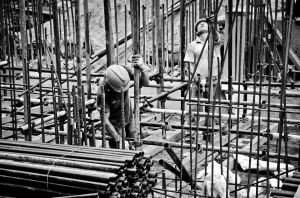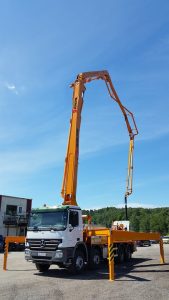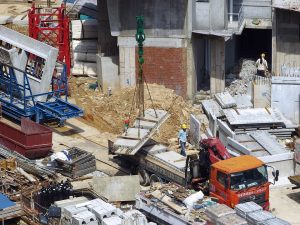Why Pump Concrete
How can you tell when you should use concrete pumping in your project?
What about this concrete placement method makes it a more efficient option compared to just using a wheelbarrow, bucketing using a crane, or dumping it out of a ready-mix truck?
Pumping concrete offers rewards in the future as well as now. Contractors report increased opportunities for additional projects and high customer satisfaction levels. Some of the distinct advantages that can have a positive impact on the bottom line of a project include labour and time savings, improved scheduling, increased profits, employee satisfaction, reduced site preparation, concrete placing versatility, and enhanced quality control.
Concrete Pumping Equipment
There is various equipment that can be used to pump concrete, including mortar machines, trailer-mounted concrete pumps, high-output/high-
pressure trailer, placing booms, and truck-mounted concrete pumps.
When any concrete placing equipment is used to equip a job site, consider the following factors:
Reliability
Site congestion
Site restrictions
Concrete mix design, admixtures, aggregate, and slump
The volume of concrete to be placed
Maximum height
Maximum distance
Safety
Job complexity
Job size
Job location
Increase Profits, Save Money, and Save Time
Concrete pumps are able to place concrete more accurately and faster with less labour involved than any of the other methods. A job that might take two and a half hours for five men to pour

would only take one hour for three men to pump. Contractors pumping concrete on a consistent basis report 50 percent labour savings compared with truck dumping.
Concrete pumping on sit allows valuable personnel to be reallocated to other responsibilities. More ready-mix trucks also can be discharged in a shorter amount of time when a pump is used, which means more jobs can be completed in one day.
Pumping Helps To Keep The Jobs Moving
One of the most crucial aspects of concrete pouring is scheduling. On busy job sites, there isn’t any room for any downtime. Contractors who have the right equipment are able to place concrete efficiently, no matter what the job site conditions, time or day, or the weather is. Getting equipment into position and manoeuvring around the job site can be critical factors as well in determining what the best concrete placing method is for you.
Concrete pumps assist mixer dispatchers by offering unloading times that are more predictable. The pump’s steady flow also can help to increase finisher productivity from the lack of delays and interruption.
Pumps, unlike human resources, always show up on time for work and do not take lunch breaks or complain. If there is a problem, there are backup systems that can keep a pump running until the job is complete, and wear parts have been designed to replace them easily.
Site preparation on a typical pour can be unpredictable, labour-intensive, and time-consuming, which can hamper efficient scheduling.
Concrete pumping can eliminate the need to built access ramps and move them and often facilitate completing an entire job at one location while ready-mix trucks being kept at the curb safely. Pumps also help to lower excavation time from 10 percent to 15 percent and also makes back-filling an easier process.
Safety And Employee Productivity
 Not only does concrete pumping make a concrete pour more consistent and convenient it also helps to improve on-the-job safety. With the ready-mix trucks stay at the curb, and away from excavations, embankments, and other dangerous obstructions so that concrete may be placed precisely where you need it.
Not only does concrete pumping make a concrete pour more consistent and convenient it also helps to improve on-the-job safety. With the ready-mix trucks stay at the curb, and away from excavations, embankments, and other dangerous obstructions so that concrete may be placed precisely where you need it.
A concrete pump also reduces congestion better at the job site compared to most other methods, which improves safety and job efficiency. A more ergonomic process and fewer risks are some major benefits for on-site employees that may result in a smoother-running business and fewer sick days.
Quality Job Each Time
Team and labor savings don’t mean anything if the concrete placement quality doesn’t meet expectations. Contractors have been pumping concrete for many years and have been able to produce superior quality while also reducing expensive callbacks. Directly placing concrete without re-handling helps to improve concrete quality as well.
For optimum quality, concrete pumping also doesn’t require any special mixes. Also, concrete pumps can handle desired slumps and get rid of the need to have excess water that may result in cracking concrete.
High-Rise Efficiency

Over the past decade, the tallest buildings that have been built were pumped, including those that are over 1,900 feet high. Capacities that are greater than 150 cubic yards an hour can be achieved by pumps. Whether on a big skyscraper or at ground level, pumping concrete is a convenient and versatile way to do the job right.
Going All The Way
Boom pumps are able to navigate over obstacles and into confined spaces are able to provide results that other methods cannot do.
Also, selecting the pump concrete may also be a function of the distance that material needs to be conveyed. Mining and tunnelling are two great examples of when pumping advantages simply cannot be ignored.

